cruise control Acura RL 2001 3.5 Owner's Manual
[x] Cancel search | Manufacturer: ACURA, Model Year: 2001, Model line: RL, Model: Acura RL 2001Pages: 333, PDF Size: 4.28 MB
Page 6 of 333
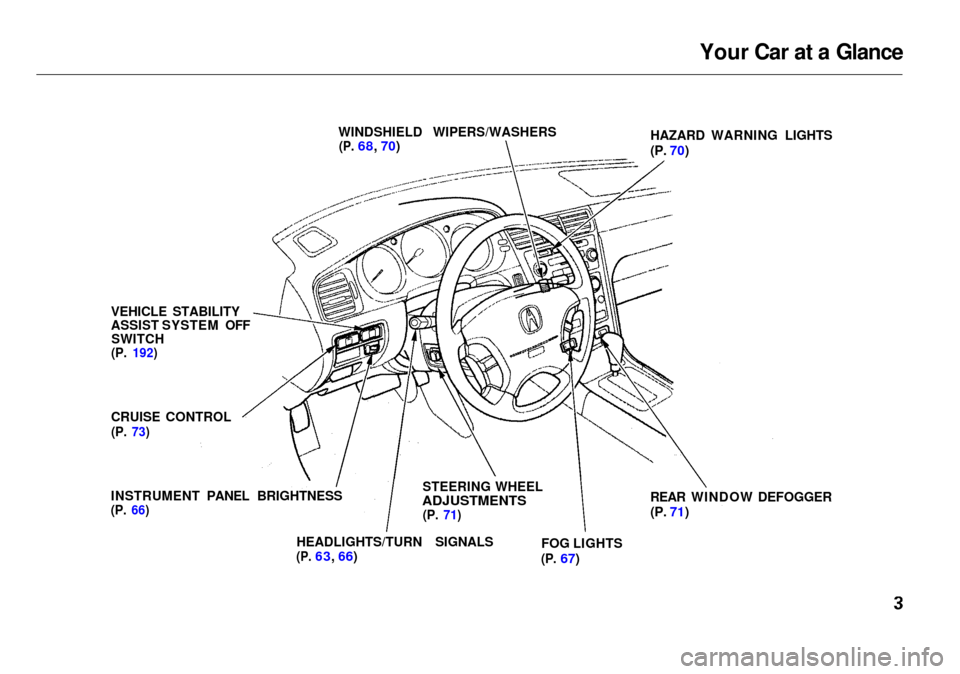
Your Car at a Glance
WINDSHIELD WIPERS/WASHERS
(P.
68, 70) HAZARD WARNING LIGHTS
(P. 70)
VEHICLE STABILITY
ASSIST SYSTEM OFF SWITCH
(P. 192)
CRUISE CONTROL
(P. 73)
INSTRUMENT PANEL BRIGHTNESS
(P. 66)
STEERING WHEEL
ADJUSTMENTS
(P. 71)
HEADLIGHTS/TURN SIGNALS
(P.
63, 66) FOG LIGHTS
(P.
67)REAR WINDOW DEFOGGER
(P. 71)
Page 54 of 333
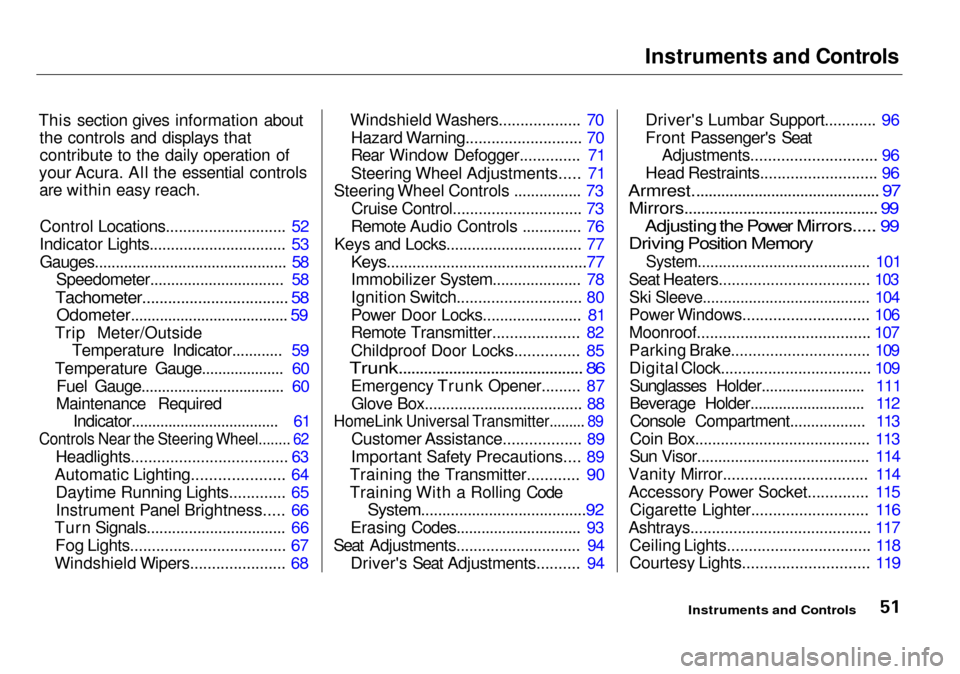
Instruments and Controls
This section gives information about the controls and displays thatcontribute to the daily operation of
your Acura. All the essential controls are within easy reach.
Control Locations............................ 52
Indicator Lights................................ 53 Gauges.............................................. 58 Speedometer................................ 58
Tachometer.................................. 58
Odometer...................................... 59
Trip Meter/Outside Temperature Indicator............ 59
Temperature Gauge.................... 60 Fuel Gauge................................... 60
Maintenance Required Indicator.................................... 61
Controls Near the Steering Wheel........ 62
Headlights.................................... 63
Automatic Lighting..................... 64 Daytime Running Lights............. 65
Instrument Panel Brightness..... 66
Turn Signals................................. 66
Fog Lights.................................... 67
Windshield Wipers...................... 68 Windshield Washers................... 70
Hazard Warning........................... 70
Rear Window Defogger.............. 71
Steering Wheel Adjustments..... 71
Steering Wheel Controls ................ 73
Cruise Control.............................. 73
Remote Audio Controls .............. 76
Keys and Locks................................ 77
Keys...............................................77
Immobilizer System..................... 78
Ignition Switch............................. 80
Power Door Locks....................... 81
Remote Transmitter.................... 82
Childproof Door Locks............... 85
Trunk............................................ 86
Emergency Trunk Opener......... 87Glove Box..................................... 88
HomeLink Universal Transmitter......... 89
Customer Assistance.................. 89
Important Safety Precautions.... 89
Training the Transmitter............ 90
Training With a Rolling Code
System.......................................92
Erasing Codes.............................. 93
Seat Adjustments............................. 94 Driver's Seat Adjustments.......... 94
Driver's Lumbar Support............ 96
Front Passenger's SeatAdjustments............................. 96
Head Restraints........................... 96
Armrest............................................. 97
Mirrors.............................................. 99
Adjusting the Power Mirrors..... 99
Driving Position Memory
System......................................... 101
Seat Heaters................................... 103
Ski Sleeve........................................ 104
Power Windows............................. 106
Moonroof........................................ 107
Parking Brake................................ 109
Digital Clock................................... 109Sunglasses Holder......................... 111
Beverage Holder............................ 112Console Compartment.................. 113
Coin Box......................................... 113
Sun Visor......................................... 114
Vanity Mirror................................. 114
Accessory Power Socket.............. 115 Cigarette Lighter........................... 116
Ashtrays.......................................... 117 Ceiling Lights................................. 118
Courtesy Lights............................. 119
Instruments and Controls
Page 56 of 333
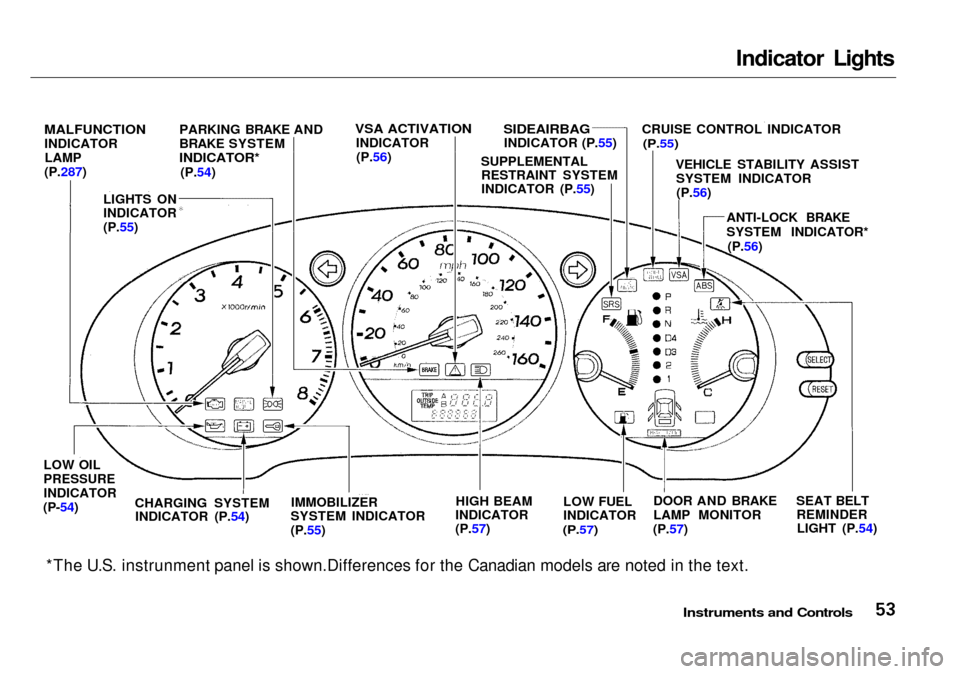
Indicator Lights
*The U.S. instrunment panel is shown.Differences for the Canadian models are noted in the text.
Instruments and Controls
MALFUNCTION
INDICATOR
LAMP
(P.287)
LIGHTS ON
INDICATOR
(P.55) PARKING BRAKE AND
BRAKE SYSTEM
INDICATOR*
(P.54)
VSA ACTIVATION
INDICATOR(P.56)
SIDEAIRBAG
INDICATOR (P.55) CRUISE CONTROL INDICATOR
(P.55)
VEHICLE STABILITY ASSISTSYSTEM INDICATOR(P.56)
ANTI-LOCK BRAKE
SYSTEM INDICATOR*(P.56)
LOW OIL
PRESSURE
INDICATOR
(P-54)
CHARGING SYSTEM
INDICATOR (P.54) IMMOBILIZER
SYSTEM INDICATOR
(P.55) HIGH BEAM
INDICATOR
(P.57) LOW FUEL
INDICATOR
(P.57)
DOOR AND BRAKE
LAMP MONITOR
(P.57) SEAT BELT
REMINDERLIGHT (P.54)
SUPPLEMENTAL
RESTRAINT SYSTEM
INDICATOR (P.55)
Page 58 of 333

Indicator Lights
Lights On Indicator
(U.S. models only)
On cars with automatic lighting (see
page 64)
This indicator reminds you that the exterior lights are on. It comes on
when the light switch is in either the or position. If you turn the
ignition switch to ACCESSORY (I)
or LOCK (0) without turning off the
light switch, this indicator will
remain on. A reminder chime willalso sound when you open the driver's
door.
This indicator will also come on
when the light switch is in AUTO and the lights turn on automatically.
Cruise Control Indicator
This lights when you set the cruise control. See page 73 for information
on operating the cruise control.
Immobilizer System
Indicator
This indicator comes on for a few seconds when you turn the ignition
switch ON (II). It will then go off if
you have inserted a properly-coded ignition key. If it is not a properly-
coded key, the indicator will blink
and the engine will not start (see
page 78).
This indicator also blinks several times when you turn the ignitionswitch from ON (II) to ACCESSORY (I) or LOCK (0).
Malfunction Indicator
Lamp
See page 287.
Supplemental Restraint
System Indicator
This indicator lights when you turn the ignition switch ON (II). If itcomes on at any other time, it
indicates a potential problem with
your front airbags. This light will also alert you to a potential problem
with your side airbags, passenger's side airbag automatic cutoff system
or automatic seat belt tensioners.
For complete information, see page
45.
Side Airbag Indicator
This indicator lights when you turn the ignition switch ON (II). If itcomes on at any other time, it
indicates that the passenger's side airbag has automatically shut off.
For complete information, see page
47.
Instruments and Controls
SRS
SIDE
AIRBAG
CRUISE
CONTROL
Page 65 of 333
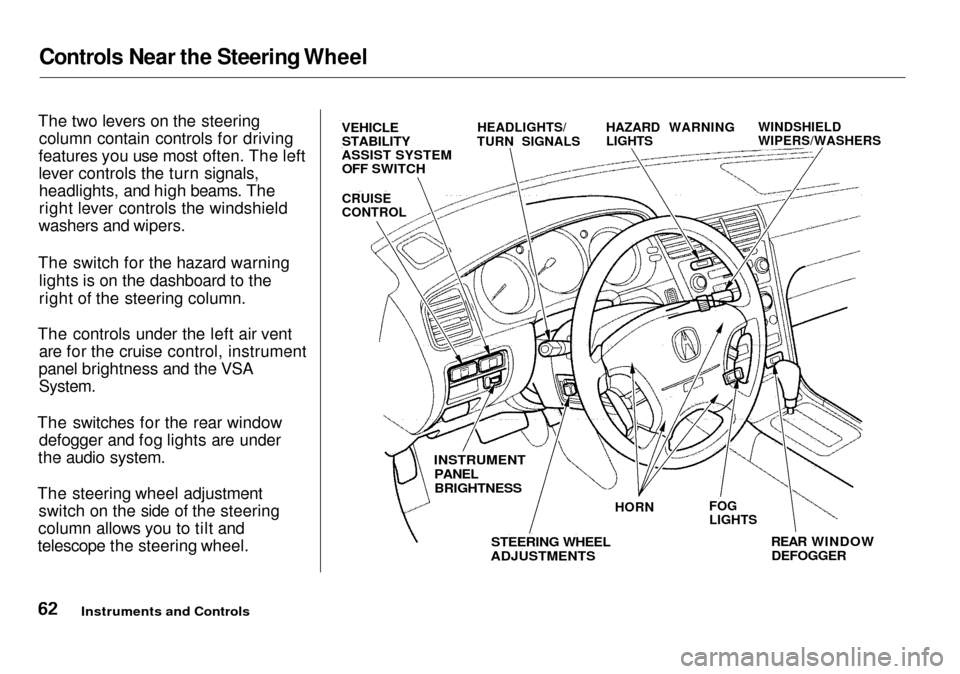
Controls Near the Steering Wheel
The two levers on the steering column contain controls for driving
features you use most often. The left
lever controls the turn signals, headlights, and high beams. The
right lever controls the windshield
washers and wipers.
The switch for the hazard warning lights is on the dashboard to the
right of the steering column.
The controls under the left air vent are for the cruise control, instrument
panel brightness and the VSA
System.
The switches for the rear window defogger and fog lights are under
the audio system.
The steering wheel adjustment switch on the side of the steering
column allows you to tilt and
telescope the steering wheel.
Instruments and Controls
VEHICLE
STABILITY
ASSIST SYSTEM
OFF SWITCH
HEADLIGHTS/
TURN SIGNALS HAZARD WARNING
LIGHTS WINDSHIELD
WIPERS/WASHERS
REAR WINDOW
DEFOGGER
HORN
FOG
LIGHTS
INSTRUMENT
PANEL
BRIGHTNESS
STEERING WHEEL
ADJUSTMENTS
CRUISE
CONTROL
Page 76 of 333

Controls Near the Steering Wheel, Steering Wheel Controls
The steering wheel then returns to its original position when you insert
the key back in the ignition switch.
Steering wheel movement is also
controlled by the Driving Position
Memory System (see page 101). Cruise Control
Cruise control allows you to maintain
a set speed above 25 mph (40 km/h)
without keeping your foot on the accelerator pedal. It should be used
for cruising on straight, open highways. It is not recommended forconditions such as city driving,
winding roads, slippery roads, heavy rain, or bad weather. You should
have full control of the car under
those conditions. Using the Cruise Control
1. Push in the Cruise Control Master Switch to the left of the steering
column. The indicator in theswitch will light.
2. Accelerate to the desired cruising speed above 25 mph (40 km/h).
CONTINUED
Instruments and Controls
CRUISE CONTROL MASTER SWITCH
Improper use of the cruise
control can lead to a crash.
Use the cruise control only
when traveling on open highways in good weather.
Page 77 of 333
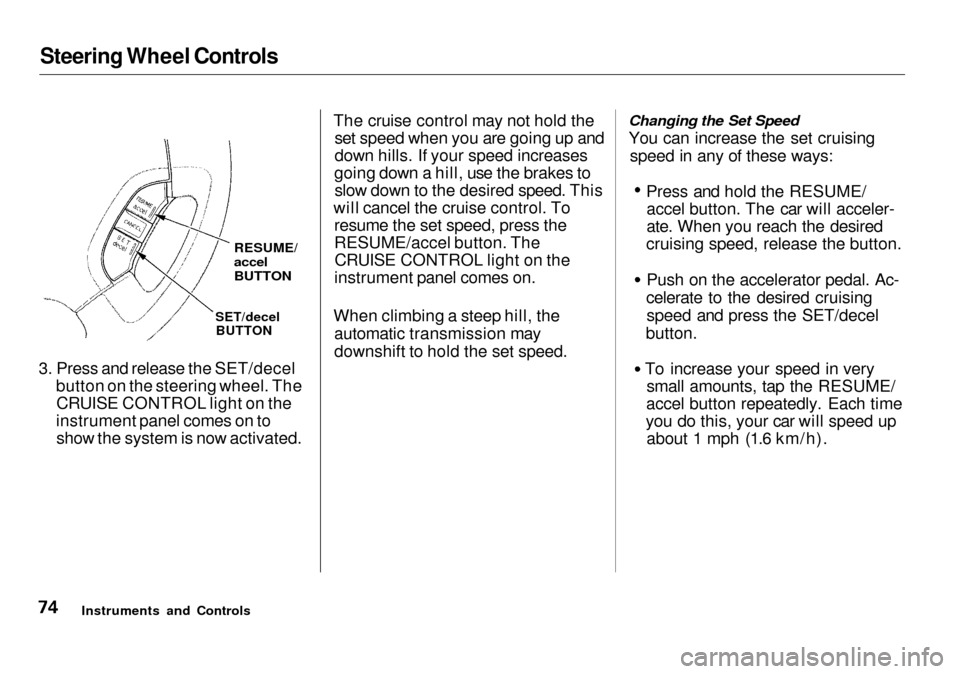
Steering Wheel Controls
3. Press and release the SET/decel button on the steering wheel. TheCRUISE CONTROL light on the
instrument panel comes on to show the system is now activated. The cruise control may not hold the
set speed when you are going up and
down hills. If your speed increases
going down a hill, use the brakes to slow down to the desired speed. This
will cancel the cruise control. To resume the set speed, press the
RESUME/accel button. TheCRUISE CONTROL light on the
instrument panel comes on.
When climbing a steep hill, the automatic transmission may
downshift to hold the set speed. Changing the Set Speed
You can increase the set cruising
speed in any of these ways: Press and hold the RESUME/
accel button. The car will acceler-
ate. When you reach the desired
cruising speed, release the button. Push on the accelerator pedal. Ac-
celerate to the desired cruising speed and press the SET/decel
button. To increase your speed in very
small amounts, tap the RESUME/
accel button repeatedly. Each time
you do this, your car will speed up about 1 mph (1.6 km/h).
Instruments and Controls
RESUME/
accel
BUTTON
SET/decel BUTTON
Page 78 of 333
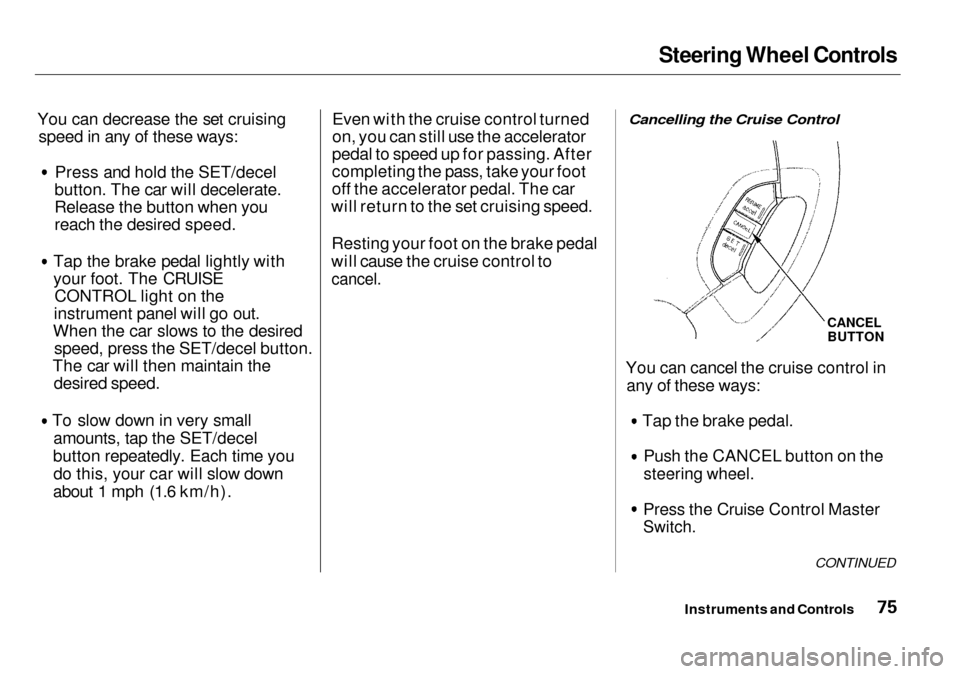
Steering Wheel Controls
You can decrease the set cruising speed in any of these ways:
Press and hold the SET/decel
button. The car will decelerate.
Release the button when you
reach the desired speed.
Tap the brake pedal lightly with
your foot. The CRUISE CONTROL light on the
instrument panel will go out.
When the car slows to the desired speed, press the SET/decel button.
The car will then maintain the desired speed. To slow down in very small
amounts, tap the SET/decel
button repeatedly. Each time you do this, your car will slow down
about 1 mph (1.6 km/h). Even with the cruise control turned
on, you can still use the accelerator
pedal to speed up for passing. After
completing the pass, take your foot
off the accelerator pedal. The car
will return to the set cruising speed.
Resting your foot on the brake pedal
will cause the cruise control to
cancel.
Cancelling the Cruise Control
You can cancel the cruise control in any of these ways:
Tap the brake pedal. Push the CANCEL button on the
steering wheel.
Press the Cruise Control Master
Switch.
Instruments and Controls
CANCEL
BUTTON
CONTINUED
Page 79 of 333
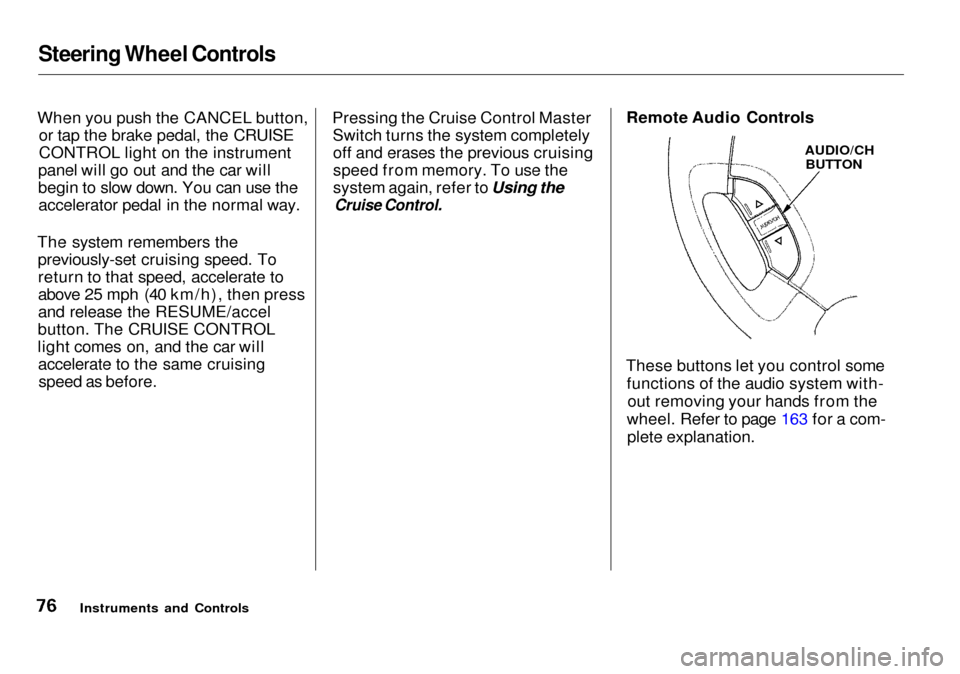
Steering Wheel Controls
When you push the CANCEL button, or tap the brake pedal, the CRUISE
CONTROL light on the instrument
panel will go out and the car will
begin to slow down. You can use the accelerator pedal in the normal way.
The system remembers the previously-set cruising speed. Toreturn to that speed, accelerate to
above 25 mph (40 km/h), then press
and release the RESUME/accel
button. The CRUISE CONTROL
light comes on, and the car will accelerate to the same cruisingspeed as before. Pressing the Cruise Control Master
Switch turns the system completelyoff and erases the previous cruising
speed from memory. To use the
system again, refer to Using the
Cruise Control.
Remote Audio Controls
These buttons let you control some functions of the audio system with-out removing your hands from the
wheel. Refer to page 163 for a com- plete explanation.
Instruments and Controls
AUDIO/CH
BUTTON
Page 176 of 333

Fuel Economy
The condition of your car and your driving habits are the two most
important things that affect the fuel
mileage you get.
Car Condition
Always maintain your car according to the maintenance schedule. This
will keep it in top operating condition.
An important part of that mainte- nance is the Owner Maintenance
Checks (see page 215 ). For
example, an underinflated tire
causes more "rolling resistance,"
which uses fuel. It also wears out
faster, so check the tire pressure at least monthly.
In winter, the build-up of snow on
your car's underside adds weight and
rolling resistance. Frequent cleaning
helps your fuel mileage and reduces
the chance of corrosion. Driving Habits
You can improve fuel economy by driving moderately. Rapid acceler-
ation, abrupt cornering, and hard
braking use more fuel.
Always drive in the highest gear that allows the engine to run and acceler-
ate smoothly.
Depending on traffic conditions, try
to maintain a constant speed. Every
time you slow down and speed up,
your car uses extra fuel. Use the cruise control, when appropriate, to
increase fuel economy. A cold engine uses more fuel than a
warm engine. It is not necessary to"warm-up" a cold engine by letting it
idle for a long time. You can drive
away in about a minute, no matter
how cold it is outside. The engine
will warm up faster, and you get
better fuel economy. To cut down on the number of "cold starts," try to
combine several short trips into one.
The air conditioning puts an extra load on the engine which makes it
use more fuel. Turn off the A/C orset the climate control to a higher
temperature to cut down on air
conditioning use. Use the flow-
through ventilation when the outside air temperature is moderate.
Before Driving